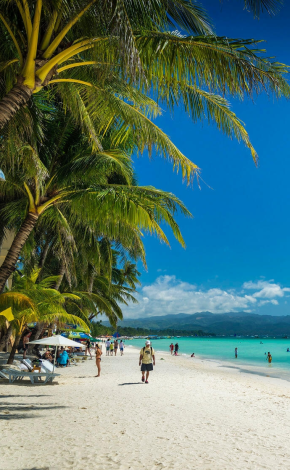What you should know about this country?
What you should know about this country?
With more than 7000 islands, the Philippines is a beach bum's delight. There's an island to suit every taste, from marooned slicks of sand in the middle of the ocean to sprawling mega-islands like Luzon and Mindanao. Sun worshippers and divers should head straight to the Visayas, where island-hopping opportunities abound and the perfect beach takes many forms. More adventurous travellers can pitch a tent on a deserted stretch of coastline and play solo Survivor for a few days.
The Philippines is a land apart from mainland Southeast Asia – not only geographically but also spiritually and culturally. The country’s overwhelming Catholicism, the result of 350 years of Spanish rule, is its most obvious enigma. Vestiges of the Spanish era include exuberant town fiestas (festivals), unique Spanish-Filipino colonial architecture and centuries-old stone churches. Malls, fast-food chains and widespread spoken English betray the influence of Spain’s colonial successor, the Americans. Yet despite these outside influences, the country remains very much its own unique entity. The people are, simply, Filipinos – and proud of it. Welcoming, warm and relentlessly upbeat, it is they who captivate and ultimately ensnare visitors.
The Philippines is a land apart from mainland Southeast Asia – not only geographically but also spiritually and culturally. The country’s overwhelming Catholicism, the result of 350 years of Spanish rule, is its most obvious enigma. Vestiges of the Spanish era include exuberant town fiestas (festivals), unique Spanish-Filipino colonial architecture and centuries-old stone churches. Malls, fast-food chains and widespread spoken English betray the influence of Spain’s colonial successor, the Americans. Yet despite these outside influences, the country remains very much its own unique entity. The people are, simply, Filipinos – and proud of it. Welcoming, warm and relentlessly upbeat, it is they who captivate and ultimately ensnare visitors.
The Philippines is defined by its emerald rice fields, teeming mega-cities, graffiti-splashed jeepneys, smouldering volcanoes, bug-eyed tarsiers, fuzzy water buffalo and smiling, happy-go-lucky people.
The Philippines is defined by its emerald rice fields, teeming mega-cities, graffiti-splashed jeepneys, smouldering volcanoes, bug-eyed tarsiers, fuzzy water buffalo and smiling, happy-go-lucky people.
What you should know about this country?
What you should know about this country?
With more than 7000 islands, the Philippines is a beach bum's delight. There's an island to suit every taste, from marooned slicks of sand in the middle of the ocean to sprawling mega-islands like Luzon and Mindanao. Sun worshippers and divers should head straight to the Visayas, where island-hopping opportunities abound and the perfect beach takes many forms. More adventurous travellers can pitch a tent on a deserted stretch of coastline and play solo Survivor for a few days.
The Philippines is a land apart from mainland Southeast Asia – not only geographically but also spiritually and culturally. The country’s overwhelming Catholicism, the result of 350 years of Spanish rule, is its most obvious enigma. Vestiges of the Spanish era include exuberant town fiestas (festivals), unique Spanish-Filipino colonial architecture and centuries-old stone churches. Malls, fast-food chains and widespread spoken English betray the influence of Spain’s colonial successor, the Americans. Yet despite these outside influences, the country remains very much its own unique entity. The people are, simply, Filipinos – and proud of it. Welcoming, warm and relentlessly upbeat, it is they who captivate and ultimately ensnare visitors.
The Philippines is a land apart from mainland Southeast Asia – not only geographically but also spiritually and culturally. The country’s overwhelming Catholicism, the result of 350 years of Spanish rule, is its most obvious enigma. Vestiges of the Spanish era include exuberant town fiestas (festivals), unique Spanish-Filipino colonial architecture and centuries-old stone churches. Malls, fast-food chains and widespread spoken English betray the influence of Spain’s colonial successor, the Americans. Yet despite these outside influences, the country remains very much its own unique entity. The people are, simply, Filipinos – and proud of it. Welcoming, warm and relentlessly upbeat, it is they who captivate and ultimately ensnare visitors.
